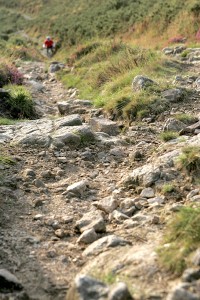
Whyte have never been afraid to do things a different way. Their first bike, the linkage forked PRST-1, was totally unlike anything available at the time and pushed the envelope for suspension performance. The Whyte 46, one of their most successful bikes, also blurred the definitions of ‘cross country’; with 6in of travel at a weight that put most of the short travel rigs of the time to shame.
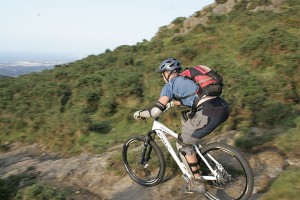
It wasn’t all plain sailing though; the PRST-1 was much better looking during night rides (or with your eyes shut) and the 46 erred on the steep side for a 6in travel bike, even with the Alpine Link that was released to relax it. The Whyte 146 has taken the technical lessons learned from previous generations of Whyte full suspension bikes and designer Ian Alexander has applied some innovative geometry and design, resulting in something that is a really rather handsome looking, aggressively poised trail bike that’s lightweight to boot.
The Detail
I’ve been riding the entrée to the 146 range, the S, costing £2,999. The carbon fibre monocoque front triangle and swingarm are swooping and sculpted, almost sinuous, especially in this white and black finish. The frame is exactly the same as that used on the £3995 ‘Works’ model and its even more exclusive sibling, the spare no cost ‘X’ at £4,999. There’s an ISCG05 guide around the Press Fit 30 oversize BB shell should you wish to use a chain device – indeed, the 146 X is one of the few off-the-shelf bikes to come so equipped.
The swingarm uses interchangeable dropouts for compatibility with almost all of the current crop of standards, though this model comes with 142mm hub spacing and 12mm quick-release through axle. It’s attached to the main frame with a pair of short and stiff links, running on lifetime warranted cartridge bearings.
The shock, nestled out of the way of filth, is a Fox RP2 with adjustable rebound and ProPedal, delivering 146mm of travel. In the tapered, integrated headset a set of 150mm travel Fox 32 Float RL forks reside. You get the extremely well mannered FIT damping cartridge with lockout and rebound adjustment but you’ll have to save your pennies for the 146X if you want a Kashima coating on them.
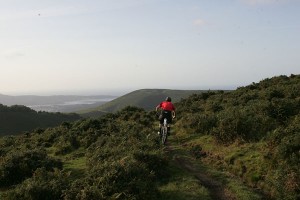
The drivetrain is from SRAM, with a full X9 group with a 39/26T double chainset. The Avid Elixir 7 brakes use a 180mm front rotor with 160mm rear and they use the neat Avid Matchmaker clamps to integrate with the shifters, keeping the 710mm wide Easton Haven bars a tidy place. The 70mm long stem (80mm long on the Large frame) is from Whyte, as is the 30.9mm seatpost. They may be own brand but they’re well made and have a quality look and feel. The QR seatclamp is a case in point – it’s forward-facing to keep muck away, has a nice lever so you don’t mangle your hands trying to shut it and the clamping mechanism has a neat design that’s friendly to carbon posts. The steel railed Fi’zi:k Gobi saddle will either have you loving or hating the curved shape: I get on with them well enough but there are others in the Singletrack office that can’t even look at one without getting sore.
Wheels are Easton’s EA70 XCT26 prebuild items. They’ve got an excellent spec, with welded tubeless aluminium rims matched to butted, straight pull spokes onto the cartridge bearing hubs. The 19mm internal and 24mm external rim width is about bang on for a bike of this travel and the Maxxis Ardent 2.25in front and Crossmax 2.1in rear sit well on them. That tyre combination speaks volumes about both the thought put into the spec and the intended use – it’s the hardcore trail centre singletrack thrasher and enduro racer’s combo of choice. The bike comes with tubes fitted, but a conversion to tubeless is just a case of adding some sealant.
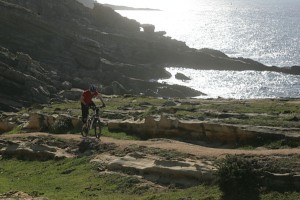
The Ride
The first thing you notice aboard the 146 is the head angle. At 66° it’s slacker than bikes with a lot more travel. As well as being downhill bike slack, it’s also long and low, all things we like in our bikes. Our medium frame has a 599mm (23.6in) top tube and it gives a riding position that inspires confidence from the very first moment. It’s an odd sensation to sit on a bike that handles as if it were a long travel, burly bike only to find it surging forwards with the slightest effort – that’s the second thing you notice.
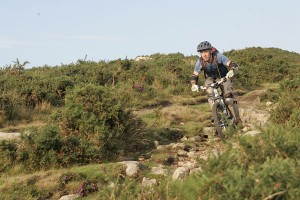
At 26lb, this bike is bloody light and that, combined with the highly torque sensitive Quad Link suspension, means it springs forward at the slightest provocation. Talking of suspension, it takes some time to find the sag sweet spot. Too much sag and the bike feels soggy, not enough and you’ll struggle to exploit all the travel on offer. I found that running somewhere closer to 25% than 30% seemed to give me the best compromise of useable travel and lively feel. Up steep climbs in the granny ring (such as it is with the 28T item) the terrain under the rear wheel is fed back noticeable through the pedals – it’s no magic carpet ride but you can extrapolate the ground beneath you and feel as the tyres dig for grip. On large hits the bike is very progressive, ramping up as you start to run towards the end of the travel.
The geometry of the 146 is something of a conjurer’s trick: sat down and spinning up big climbs, it feels just like a fairly standard trail bike, albeit a rangey one. It’s stable, not prone to any uphill handling oddities and doesn’t feel ponderous despite the choppered-out angles. It’s a very comfortable place to be for extended durations in the saddle. Stand up and the work that’s been put into the relationships between front wheel, rear wheel and bottom bracket mean that the bike suddenly changes character completely. It urges you to ride faster, hit corners harder and still feels light on its toes. Half ballerina, half bar fighter.
There’s a bit of a penalty for the confidence it encourages. It’s still a lightweight bike despite that burly feel and when you get stuck into the rough stuff it gets knocked off line, just as you’d expect from a 26lb bike – a victim of its own aptitude if you will. If you’re willing to work for it, then it can be hustled through some seriously technical terrain – but you will start to notice a bit of twang from the lightweight wheels and back end. It’s nothing deleterious, just a warning that you’re riding at the limit of what you should be doing on a bike this light.
Treating it like a miniature downhill bike misses the point of the 146 anyway. Keep the bike to what it’s supposed to do and it’s a rapid and involving ride, big on feedback and character. Trail centre loops will get somehow shorter, your favourite descents will fly by at a new speed and your local woods will shrink in size. You’ll get yourself into all kinds of trouble – and back out of it, too.
Overall: It’s a trail bike with a split personality. It’ll do distance riding with aplomb and encourage you to get carried away on descents. It’ll reward the skilled and flatter fitness with it’s light weight and handling. As you’d expect from British brand Whyte, it’s a bike that excels at the vast majority of UK trail riding. Don’t let it fool you into thinking you’re on a downhill bike though…
Jon.
Review Info
| Brand: | Whyte |
| Product: | 146 S |
| From: | Whyte Bikes www.whytebikes.com |
| Price: | £2,999 |
| Tested: | by Jon for three months |
Comments (0)
Leave Reply
Post Comment
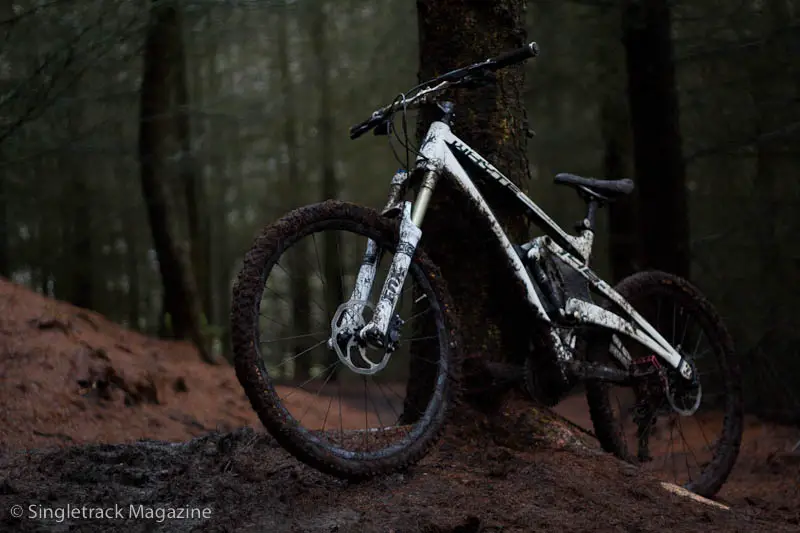

“Their first bike, the linkage forked PRST-1, was totally unlike anything available at the time and post the envelope for suspension performance.”
I hope there was a stamp on that envelope. 😉
Letterbox corrected 😉
lovely looking bike
Wonder if they’d px my E120?…that 146 looks lovely!
nice write up
I have one and love i
“the terrain under the rear wheel is fed back noticeable through the pedals – it’s no magic carpet ride but you can extrapolate the ground beneath you and feel as the tyres dig for grip”
What does this actually mean?
Well written again, well done. Nice to see someone not feeling obliged to dumb-down their vocabulary and taking the time to craft the odd adventurous sentence. Good review too! Great stuff!
“the linkage forked PRST-1, was totally unlike anything available at the time ”
The BMW ‘supertech’ wasnt around at the same time then, ~1997? (I dont know when the PRST’s first came out)
@ Farmer John, presumably means you feel the bumps/terrain through the chain/pedalling?
I’ve got one as well, it’s an amazing bit of kit and made me far more confident on steeper descents…
Farmer John – what’s meant there is that there’s a fair amount of feedback from bumps through to the pedals. Whether you find that reassuring or annoying will really depend on your own preferences.
James – The PRST-1 was released in ’99 though, so BMW may have beaten them to the drop on that style of linkage fork on a bicycle. I can’t seem to find out for sure if Jon Whyte was involved in the BMW Supertech, but I think he may have been – anyone know for certain?
Broken ones so far……..?????
How many have broken so far?
Love the bike, had one out on test ride; busy saving money to be able to go into shop and buy one; is the works worth the extra grand?